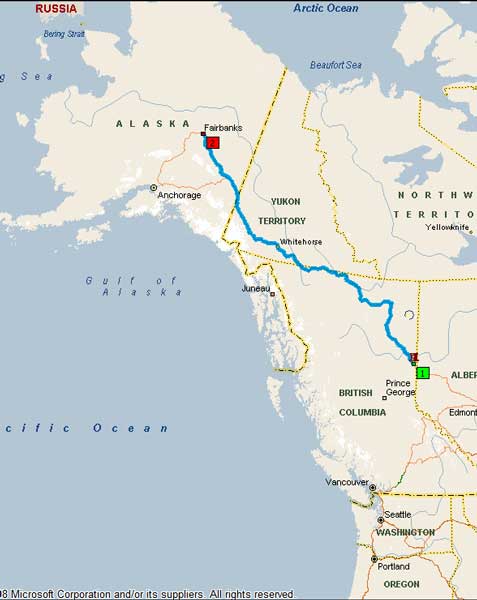Tom's Journal - The Alaska Highway Overview
An Overview of the building of the Alaska Highway

The Alaska Highway had its first beginnings in the early 1900 when several dudes, and probably dudets proposed and lobbied for a road connecting the lower forty-eight states to Alaska. There were several different routes proposed and explored but the project never got off the ground due to numerous bureaucratic, political, and financial issues. Much of the bureaucracy had to do with politics between the US and Canada; Canada didn't particularly see an advantage to building a road and who would pay for and maintain it and it would lead to further influence from the States.
Well, then along came a war--you may have read about it, it was called World Word II--and the US and Canadian militaries thought it prudent to build a supply route from the US to Alaska. The defense of Alaska and the Aleutian Islands in the Pacific was of strategic importance. In WWII, Japan saw the Aleutian Islands as a base for attacks across the Pacific. They actually did attack and temporarily hold a couple of the Aleutian islands. There was also a series of airfields and bases built through Canada to Alaska to shuttle aircraft and supplies to Alaska and to send aircraft to Russia for the war in Europe.
The US and Canadian governments agreed that a road should be built to Alaska. Canada would provide the tundra and the US would provide the labor and the "funda." The war overcame the insurmountable bureaucracies and politics although Roosevelt singed the order in February 1942 and surveying work began before the Canadian Prime Minister signed the treaty a month later in March. In March 1942, the US Army Corp of Engineers began construction on this incredible feat; 1,500 miles of roadway through the harsh north of Canada and Alaska in eight months (it was supposed to be completed in eight). A (barely) usable military road was built completed in November.
Building a road through the mountains, rivers, streams, and frozen tundra was a construction marvel. Besides the numerous known challenges they faced, there were many more unforeseen challenges. For example, permafrost when excavated turned to slush, bogs of mud that corduroy lumber paths where built on top of, and muddy marshes that had to be built around, and other areas that in 1942 could not be constructed on.
The building of the road proceeded with the military surveyors surveying a route often only a day or two ahead of the builders. Following the surveyors, the Army Corp would follow laying a rough military road that was "passable" by military vehicles. Following them, other Army Corp and numerous civilian contracting companies improved the road and laid the permanent road. Later in the construction, the Army realized that they had to enlist the aid of the civilian contractors to complete the military road before winter. Work on the permanent road continued on in winter and in 1943 by civilian contractors. The work conditions with mud, mosquitoes, rain, snow, rivers, and around the clock construction (14-18 hours shifts), seven days a week made the conditions truly horrendous.
The road started in Dawson Creek (Mile 0) and proceeded north. Work also began in Delta Junction Alaska (mile 1422) and proceeded south and from Whitehorse proceeding in both directions with supplies coming in from Skagway via the Whitehorse and Yukon railway (built for the gold rush).
During construction, the road was called the ALCAN Highway but in 1947 received the official name the Alaska Highway.
While called the Alaska Highway, its 1400+ miles is actually just less than 1200 miles in Canada and only about 300 miles in Alaska. The modern highway is a much improved two lane road (but always under repair due to winter conditions) that follows the same basic route. But, with modern construction techniques, many of the turns and circumventions have been removed to improve and maintain the road. The original road was also built to service and supply the airstrips and bases being built but that is no longer a requirement.